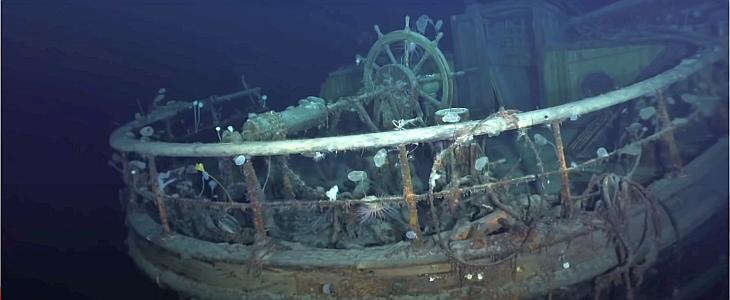 The Endurance22 Expedition announced yesterday that they have discovered the wreck of Sir Ernest Shackleton‘s ship Endurance, which was crushed by pack ice off Antarctica in 1915. The ship was in remarkably good condition. How is it that the ship is so well preserved after having been sitting on the bottom 10,000 feet beneath the Southern Ocean for over a century?
The Endurance22 Expedition announced yesterday that they have discovered the wreck of Sir Ernest Shackleton‘s ship Endurance, which was crushed by pack ice off Antarctica in 1915. The ship was in remarkably good condition. How is it that the ship is so well preserved after having been sitting on the bottom 10,000 feet beneath the Southern Ocean for over a century?
The BBC notes that the ship looks much the same as when photographed for the last time by Shackleton’s filmmaker, Frank Hurley, in 1915. The masts are down, the rigging is in a tangle, but the hull is broadly coherent. Some damage is evident at the bow, presumably where the descending ship hit the seabed. The anchors are present. The subs even spied some boots and crockery.
“You can even see the ship’s name – E N D U R A N C E – arced across its stern directly below the taffrail (a handrail near the stern). And beneath, as bold as brass, is Polaris, the five-pointed star, after which the ship was originally named,” said marine archaeologist Mensun Bound.
“The Endurance, looking like a ghost ship, is sprinkled with an impressive diversity of deep-sea marine life – stalked sea squirts, anemones, sponges of various forms, brittlestars, and crinoids (related to urchins and sea stars), all filter feeding nutrition from the cool deep waters of the Weddell Sea,” commented deep-sea polar biologist Dr. Michelle Taylor from Essex University.
The one form of life that is missing, however, is the bane of wooden ships and boats, the shipworm. Scientists only discovered that shipworms do not live in the Southern Ocean less than a decade ago. The only other two areas of the ocean with a deficit of shipworms are the Baltic and the Black Sea, both of which are sufficiently brackish to be less attractive to the worms, which are technically a type of mollusk.
The Southern Ocean is not brackish, so why are there no shipworms? The answer appears to be that there are no trees. In fact, there have been no trees in the Antarctic region for something like 30 million years. There has been nothing for shipworms to eat, notwithstanding the occasional and infrequent shipwreck.
There are indeed marine worms in the Southern Ocean but they eat bones rather than wood. Bone-eating worms have a rich source of food – whale bones. The Southern Ocean has one of the highest populations of whales of any ocean in the world. It is bone-worm heaven.
In a paper from 2013, Bone-eating worms from the Antarctic: the contrasting fate of whale and wood remains on the Southern Ocean seafloor, in the Proceedings of the Royal Society B, a group of researchers monitored what happened to wood and whalebone underwater on the Southern Ocean seafloor. The whalebone was attacked by several species of bone-eating worm, while the wood was left untouched.
The absence of shipworms has allowed the wreck of the Endurance to endure for 107 years, preserving a veritable time capsule for marine archaeologists and historians.

A museum ship of a kind.
I suppose it’ll be a while until a drone can enter. Until then, Frank Hurley will be (I think) the last to have been down below deck. Years after reading about it I still find it astounding that Hurley actually dove into the crumbling ship to retrieve cans of exposed film he’d wisely soldered closed.
And no cozy place for Hurley to warm up afterwards. Sometimes it seems as though people of those days were another species entirely.